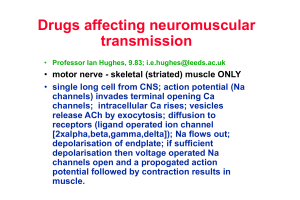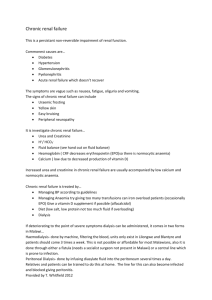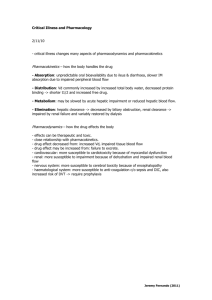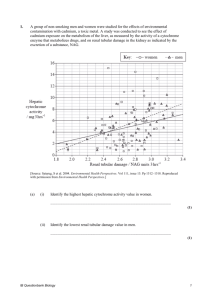Renal cat - Lakeview Veterinary Centre
advertisement
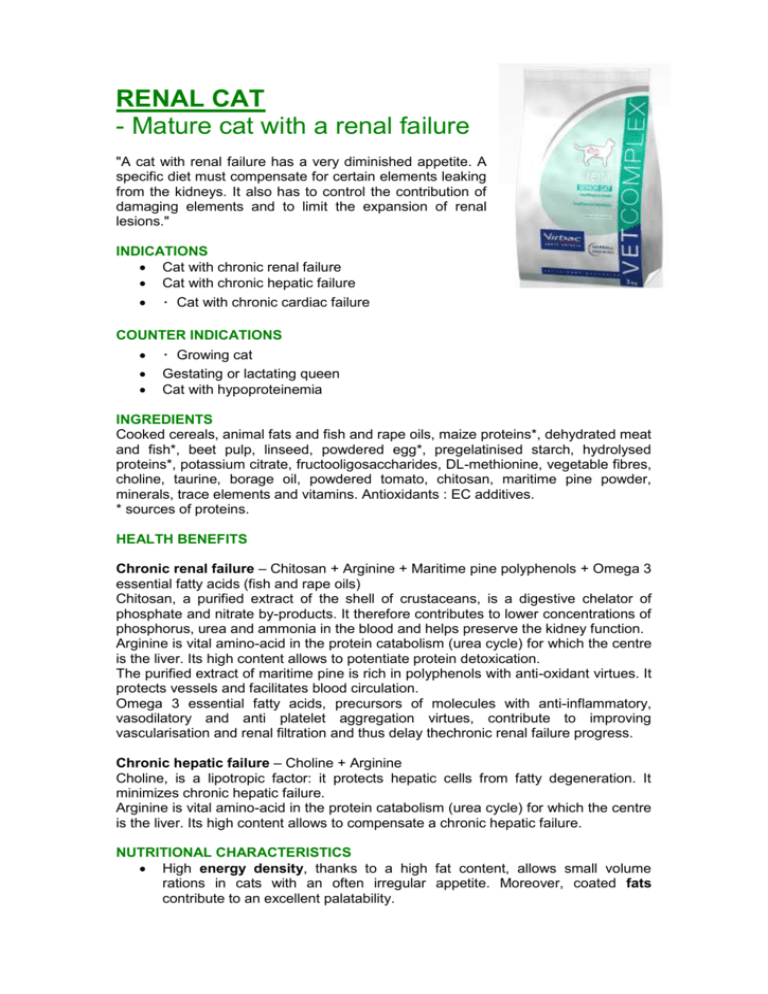
RENAL CAT - Mature cat with a renal failure "A cat with renal failure has a very diminished appetite. A specific diet must compensate for certain elements leaking from the kidneys. It also has to control the contribution of damaging elements and to limit the expansion of renal lesions." INDICATIONS Cat with chronic renal failure Cat with chronic hepatic failure Cat with chronic cardiac failure COUNTER INDICATIONS Growing cat Gestating or lactating queen Cat with hypoproteinemia INGREDIENTS Cooked cereals, animal fats and fish and rape oils, maize proteins*, dehydrated meat and fish*, beet pulp, linseed, powdered egg*, pregelatinised starch, hydrolysed proteins*, potassium citrate, fructooligosaccharides, DL-methionine, vegetable fibres, choline, taurine, borage oil, powdered tomato, chitosan, maritime pine powder, minerals, trace elements and vitamins. Antioxidants : EC additives. * sources of proteins. HEALTH BENEFITS Chronic renal failure – Chitosan + Arginine + Maritime pine polyphenols + Omega 3 essential fatty acids (fish and rape oils) Chitosan, a purified extract of the shell of crustaceans, is a digestive chelator of phosphate and nitrate by-products. It therefore contributes to lower concentrations of phosphorus, urea and ammonia in the blood and helps preserve the kidney function. Arginine is vital amino-acid in the protein catabolism (urea cycle) for which the centre is the liver. Its high content allows to potentiate protein detoxication. The purified extract of maritime pine is rich in polyphenols with anti-oxidant virtues. It protects vessels and facilitates blood circulation. Omega 3 essential fatty acids, precursors of molecules with anti-inflammatory, vasodilatory and anti platelet aggregation virtues, contribute to improving vascularisation and renal filtration and thus delay thechronic renal failure progress. Chronic hepatic failure – Choline + Arginine Choline, is a lipotropic factor: it protects hepatic cells from fatty degeneration. It minimizes chronic hepatic failure. Arginine is vital amino-acid in the protein catabolism (urea cycle) for which the centre is the liver. Its high content allows to compensate a chronic hepatic failure. NUTRITIONAL CHARACTERISTICS High energy density, thanks to a high fat content, allows small volume rations in cats with an often irregular appetite. Moreover, coated fats contribute to an excellent palatability. The precise protein contribution and proteins of high biological value help combat uraemia and avoid overloading the hepatic metabolization process. High soluble fibre content helps reduce nitrogen levels in the body. Low phosphorus content helps combat hyperphosphatemia and protects the renal function. Unchanged levels of calcium help combat secondary hyperparathyroidism. High potassium content compensates for renal leakage. Low sodium content helps combat high blood pressure. Richness in vitamin E, selenium and tomato lycopene, an anti-oxidant complex, protects against cell ageing and helps curb vascular, cardiac and renal lesions. TYPICAL ANALYSIS Moisture ........................................................................................ 8 % Crude protein .............................................................................. 27 % Crude fat ..................................................................................... 24 % Minerals ........................................................................................ 5 % Crude fibre .................................................................................... 3 % Soluble fibres ................................................................................ 1 % Insoluble fibres .............................................................................. 5 % NFE ............................................................................................. 33 % Starch.......................................................................................... 24 % Calcium ...................................................................................... 0.8 % Phosphorus ............................................................................... 0.4 % Ca/P .................................................................................................. 2 Essential Fatty Acids ................................................................. 4.7 % ω6/ω3 ratio ...................................................................................... 4 Added chitosan ................................................................... 400 mg/kg Added tomato lycopene ...................................................... 500 mg/kg Added maritime pine polyphenols ......................................... 20 mg/kg Added choline ..................................................................... 908 mg/kg Arginine ...................................................................................... 1.4 % Metabolisable energy (FEDIAF formula) .......................... 384 kcal/100g Measured metabolisable energy ............................... 437 kcal/100g PCR ................................................................................... 70 g/Mcal Average digestibility ................................................................ 91 % Urinary pH ............................................................................. 6.9 – 7.1 Vitamin A ......................................................................... 10000 UI/kg Vitamin D3 ........................................................................ 1000 UI/kg Vitamin E ............................................................................. 500 mg/kg
